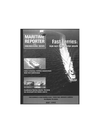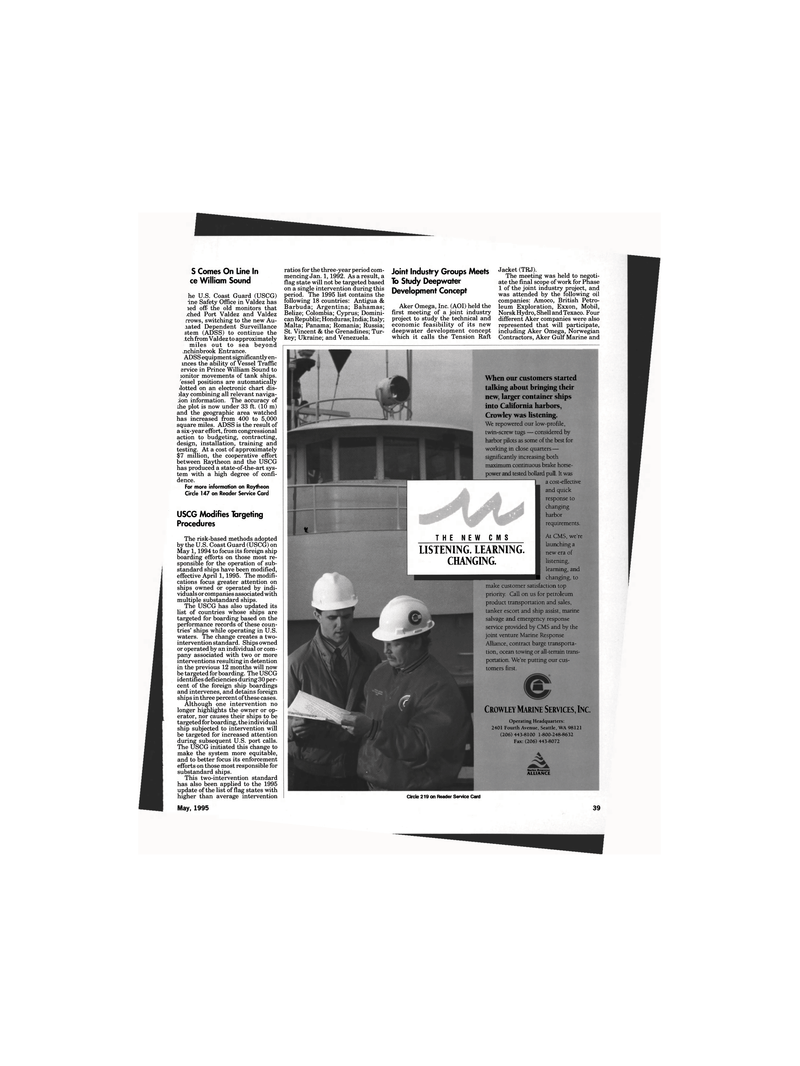
Page 37: of Maritime Reporter Magazine (May 1995)
Read this page in Pdf, Flash or Html5 edition of May 1995 Maritime Reporter Magazine
S Comes On Line In ce William Sound he U.S. Coast Guard (USCG) ine Safety Office in Valdez has led off the old monitors that ,ched Port Valdez and Valdez rrows, switching to the new Au- aated Dependent Surveillance stem (ADSS) to continue the .tch from Valdez to approximately miles out to sea beyond jichinbrook Entrance.
ADSS equipment significantly en- mces the ability of Vessel Traffic ervice in Prince William Sound to lonitor movements of tank ships. ressel positions are automatically ilotted on an electronic chart dis- may combining all relevant naviga- ;ion information. The accuracy of the plot is now under 33 ft. (10 m) and the geographic area watched has increased from 400 to 5,000 square miles. ADSS is the result of a six-year effort, from congressional action to budgeting, contracting, design, installation, training and testing. At a cost of approximately $7 million, the cooperative effort between Raytheon and the USCG has produced a state-of-the-art sys- tem with a high degree of confi- dence.
For more information on Raytheon
Circle 147 on Reader Service Card
USCG Modifies Targeting
Procedures
The risk-based methods adopted by the U.S. Coast Guard (USCG) on
May 1,1994 to focus its foreign ship boarding efforts on those most re- sponsible for the operation of sub- standard ships have been modified, effective April 1, 1995. The modifi- cations focus greater attention on ships owned or operated by indi- viduals or companies associated with multiple substandard ships.
The USCG has also updated its list of countries whose ships are targeted for boarding based on the performance records of these coun- tries' ships while operating in U.S. waters. The change creates a two- intervention standard. Ships owned or operated by an individual or com- pany associated with two or more interventions resultingin detention in the previous 12 months will now be targeted for boarding. The USCG identifies deficiencies during 30 per- cent of the foreign ship boardings and intervenes, and detains foreign ships in three percent of these cases.
Although one intervention no longer highlights the owner or op- erator, nor causes their ships to be targeted for boarding, the individual ship subjected to intervention will be targeted for increased attention during subsequent U.S. port calls.
The USCG initiated this change to make the system more equitable, and to better focus its enforcement efforts on those most responsible for substandard ships.
This two-intervention standard has also been applied to the 1995 update of the list of flag states with higher than average intervention ratios for the three-year period com- mencing Jan. 1,1992. As a result, a flag state will not be targeted based on a single intervention during this period. The 1995 list contains the following 18 countries: Antigua &
Barbuda; Argentina; Bahamas;
Belize; Colombia; Cyprus; Domini- can Republic; Honduras; India; Italy;
Malta; Panama; Romania; Russia;
St. Vincent & the Grenadines; Tur- key; Ukraine; and Venezuela.
Joint Industry Groups Meets
To Study Deepwater
Development Concept
Aker Omega, Inc. (AOI) held the first meeting of a joint industry project to study the technical and economic feasibility of its new deepwater development concept which it calls the Tension Raft
Jacket (TRJ).
The meeting was held to negoti- ate the final scope of work for Phase 1 of the joint industry project, and was attended by the following oil companies: Amoco, British Petro- leum Exploration, Exxon, Mobil,
Norsk Hydro, Shell and Texaco. Four different Aker companies were also represented that will participate, including Aker Omega, Norwegian
Contractors, Aker Gulf Marine and *
When our customers started talking about bringing their new, larger container ships into California harbors,
Crowley was listening.
We repowered our low-profile, twin-screw tugs — considered by harbor pilots as some of the best for working in close quarters — significantly increasing both maximum continuous brake horse- power and tested bollard pull. It was ' "U a cost-effective and quick response to changing harbor requirements.
THE NEW CMS
LISTENING. LEARNING.
CHANGING.
At CMS, we're launching a new era of listening, learning, and •HHHIHHHHH changing, to make customer satisfaction top priority. Call on us for petroleum product transportation and sales, tanker escort and ship assist, marine salvage and emergency response service provided by CMS and by the joint venture Marine Response
Alliance, contract barge transporta- tion, ocean towing or all-terrain trans- portation. We're putting our cus- tomers first.
CROWLEY MARINE SERVICES, INC.
Operating Headquarters: 2401 Fourth Avenue, Seattle, WA 98121 (206) 443-8100 1-800-248-8632
Fax: (206) 443-8072
Marine Response
ALLIANCE
Circle 219 on Reader Service Card
May, 1995 39

 36
36

 38
38
